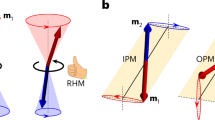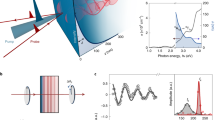Abstract
Antiferromagnets (AFMs) have the potential to push spintronic devices from a static condition or gigahertz frequency range to the terahertz range for the sake of high-speed processing. However, the insensitivity of AFMs to magnetic fields makes the manipulation of spin currents difficult. The ultrafast generation of the spin current in ferromagnet/heavy-metal (HM) structures has received a lot of attention in recent years, but whether a similar scenario can be observed in an AFM/HM system is still unknown. Here, we show the optical generation of ultrafast spin current in an AFM/HM heterostructure at zero external magnetic field and at room temperature by detecting the associated terahertz emission. We believe that this is a common phenomenon in antiferromagnets with strong nonlinear optical effects. Our results open an avenue of fundamental research into antiferromagnetism and a route to AFM spintronic devices.
This is a preview of subscription content, access via your institution
Access options
Access Nature and 54 other Nature Portfolio journals
Get Nature+, our best-value online-access subscription
$29.99 / 30 days
cancel any time
Subscribe to this journal
Receive 12 print issues and online access
$209.00 per year
only $17.42 per issue
Buy this article
- Purchase on Springer Link
- Instant access to full article PDF
Prices may be subject to local taxes which are calculated during checkout




Similar content being viewed by others
Data availability
Source data are provided for this paper. All other data that support the plots within this paper and other findings of this study are available from the corresponding author upon reasonable request.
References
Jungwirth, T., Marti, X., Wadley, P. & Wunderlich, J. Antiferromagnetic spintronics. Nat. Nanotechnol. 11, 231–241 (2016).
Kimel, A. V. et al. Inertia-driven spin switching in antiferromagnets. Nat. Phys. 5, 727–731 (2009).
Kampfrath, T. et al. Coherent terahertz control of antiferromagnetic spin waves. Nat. Photon. 5, 31–34 (2010).
Baltz, V. et al. Antiferromagnetic spintronics. Rev. Mod. Phys. 90, 015005 (2018).
Železný, J., Wadley, P., Olejník, K., Hoffmann, A. & Ohno, H. Spin transport and spin torque in antiferromagnetic devices. Nat. Phys. 14, 220–228 (2018).
Cheng, R., Xiao, J., Niu, Q. & Brataas, A. Spin pumping and spin-transfer torques in antiferromagnets. Phys. Rev. Lett. 113, 057601 (2014).
Wu, S. M. et al. Antiferromagnetic spin Seebeck effect. Phys. Rev. Lett. 116, 097204 (2016).
Seki, S. et al. Thermal generation of spin current in an antiferromagnet. Phys. Rev. Lett. 115, 266601 (2015).
Němec, P., Fiebig, M., Kampfrath, T. & Kimel, A. V. Antiferromagnetic opto-spintronics. Nat. Phys. 14, 229–241 (2018).
Manz, S. et al. Reversible optical switching of antiferromagnetism in TbMnO3. Nat. Photon. 10, 653–656 (2016).
Satoh, T. et al. Excitation of coupled spin–orbit dynamics in cobalt oxide by femtosecond laser pulses. Nat. Commun. 8, 638 (2017).
Sänger, I., Pavlov, V. V., Bayer, M. & Fiebig, M. Distribution of antiferromagnetic spin and twin domains in NiO. Phys. Rev. B 74, 144401 (2006).
Tzschaschel, C. et al. Ultrafast optical excitation of coherent magnons in antiferromagnetic NiO. Phys. Rev. B 95, 174407 (2017).
Higuchi, T., Kanda, N., Tamaru, H. & Kuwata-Gonokami, M. Selection rules for light-induced magnetization of a crystal with threefold symmetry: the case of antiferromagnetic NiO. Phys. Rev. Lett. 106, 047401 (2011).
Shen, L. Q. et al. Dominant role of inverse Cotton–Mouton effect in ultrafast stimulation of magnetization precession in undoped yttrium iron garnet films by 400-nm laser pulses. Phys. Rev. B 97, 224430 (2018).
Kimel, A. V. et al. Ultrafast non-thermal control of magnetization by instantaneous photomagnetic pulses. Nature 435, 655–657 (2005).
Bossini, D. & Rasing, Th. Femtosecond optomagnetism in dielectric antiferromagnets. Phys. Scr. 92, 024002 (2017).
Saidl, V. et al. Optical determination of the Néel vector in a CuMnAs thin-film antiferromagnet. Nat. Photon. 11, 91–96 (2017).
Seifert, T. S. et al. Femtosecond formation dynamics of the spin Seebeck effect revealed by terahertz spectroscopy. Nat. Commun. 9, 2899 (2018).
Nishitani, J., Kozuki, K., Nagashima, T. & Hangyo, M. Terahertz radiation from coherent antiferromagnetic magnons excited by femtosecond laser pulses. Appl. Phys. Lett. 96, 221906 (2010).
Kampfrath, T. et al. Terahertz spin current pulses controlled by magnetic heterostructures. Nat. Nanotechnol. 8, 256–260 (2013).
Seifert, T. et al. Efficient metallic spintronic emitters of ultrabroadband terahertz radiation. Nat. Photon. 10, 483–488 (2016).
Huisman, T. J. et al. Femtosecond control of electric currents at the interfaces of metallic ferromagnetic heterostructures. Nat. Nanotechnol. 11, 455–458 (2015).
Jungfleisch, M. B. et al. Control of terahertz emission by ultrafast spin-charge current conversion at Rashba interfaces. Phys. Rev. Lett. 120, 207207 (2018).
Qiu, H. S. et al. Layer thickness dependence of the terahertz emission based on spin current in ferromagnetic heterostructures. Opt. Express 26, 15247–15254 (2018).
Feng, Z. et al. Highly efficient spintronic terahertz emitter enabled by metal–dielectric photonic crystal. Adv. Opt. Mater. 6, 1800965 (2018).
Chen, M., Mishra, R., Wu, Y., Lee, K. & Yang, H. Terahertz emission from compensated magnetic heterostructures. Adv. Opt. Mater. 6, 1800430 (2018).
Komandin, G. A., Porodinkov, O. E., Spector, I. E. & Volkov, A. A. Multiphonon absorption in a MgO single crystal in the terahertz range. Phys. Solid State 51, 2045 (2009).
Fiebig, M. et al. Second harmonic generation in the centrosymmetric antiferromagnet NiO. Phys. Rev. Lett. 87, 137202 (2001).
Saitoh, E., Ueda, M., Miyajima, H. & Tatara, G. Conversion of spin current into charge current at room temperature: inverse spin-Hall effect. Appl. Phys. Lett. 88, 182509 (2006).
Sinova, J., Valenzuela, S. O., Wunderlich, J., Back, C. H. & Jungwirth, T. Spin Hall effects. Rev. Mod. Phys. 87, 1213–1260 (2015).
Soumyanarayanan, A., Reyren, N., Fert, A. & Panagopoulos, C. Emergent phenomena induced by spin–orbit coupling at surfaces and interfaces. Nature 539, 509–517 (2016).
Lesne, E. et al. Highly efficient and tunable spin-to-charge conversion through Rashba coupling at oxide interfaces. Nat. Mater. 15, 1261–1266 (2016).
Zhou, C. et al. Broadband terahertz generation via the interface inverse Rashba–Edelstein effect. Phys. Rev. Lett. 121, 086801 (2018).
Cheng, L. et al. Far out-of-equilibrium spin populations trigger giant spin injection into atomically thin MoS2. Nat. Phys. 15, 347–351 (2019).
Zhang, X.-C. & Auston, D. H. Optoelectronic measurement of semiconductor surfaces and interfaces with femtosecond optics. J. Appl. Phys. 71, 326–338 (1992).
Welsh, G. H., Hunt, N. T. & Wynne, K. Terahertz-pulse emission through laser excitation of surface plasmons in a metal grating. Phys. Rev. Lett. 98, 026803 (2007).
Li, G. et al. Laser induced THz emission from femtosecond photocurrents in Co/ZnO/Pt and Co/Cu/Pt multilayers. J. Phys. D 51, 134001 (2018).
Choi, G.-M., Min, B.-C., Lee, K.-J. & Cahill, D. G. Spin current generated by thermally driven ultrafast demagnetization. Nat. Commun. 5, 4334 (2014).
Satoh, T. et al. Spin oscillations in antiferromagnetic NiO triggered by circularly polarized light. Phys. Rev. Lett. 105, 077402 (2010).
Kanda, N. et al. The vectorial control of magnetization by light. Nat. Commun. 2, 362 (2011).
Tserkovnyak, Y., Brataas, A., Bauer, G. E. W. & Halperin, B. I. Nonlocal magnetization dynamics in ferromagnetic heterostructures. Rev. Mod. Phys. 77, 1375–1421 (2005).
Adachi, H., Uchida, K., Saitoh, E. & Maekawa, S. Theory of the spin Seebeck effect. Rep. Prog. Phys. 76, 036501 (2013).
Tserkovnyak, Y., Brataas, A. & Bauer, G. E. W. Enhanced Gilbert damping in thin ferromagnetic films. Phys. Rev. Lett. 88, 117601 (2002).
Acknowledgements
This work was partially supported by the National Natural Science Foundation of China (grant nos. 61521001, 61731010, 61671234, 11727808 and 11674159), National Key Research and Development Program of China (grant nos. 2017YFA0700202 and 2017YFA0303202), and Natural Science Foundation of Jiangsu Province (grant no. BK20190300). It was also partially supported by the Fundamental Research Funds for the Central Universities and by the Jiangsu Key Laboratory of Advanced Techniques for Manipulating Electromagnetic Waves. We acknowledge B. G. Wang and C. Zhang for their discussion on the mechanism of the spin current generation. We thank Y. F. Nie for helping to confirm the crystallographic orientation of the sample through the φ-scan measurement.
Author information
Authors and Affiliations
Contributions
D.W. and B.J. conceived and instructed this work. L.Z. and Y.T. fabricated and characterized the AFM/NM samples. H.Q. built the terahertz emission setup on the basis of preliminary work by C.Z. and performed the terahertz experiments. S.C. and S.M. provided the high-quality HAADF-STEM image. H.Z. and Q.Z. provided very revealing comments on the physical mechanism of the ultrafast interaction between light and matter. J.W., J.C. and P.W. contributed to the electrodynamic explanations for the THz experiments. H.Q. and L.Z. analysed experimental data and wrote the manuscript with contributions from all of the authors.
Corresponding authors
Ethics declarations
Competing interests
The authors declare no competing interests.
Additional information
Publisher’s note Springer Nature remains neutral with regard to jurisdictional claims in published maps and institutional affiliations.
Supplementary information
Supplementary Information
Supplementary Sections 1–5 and Figs. 1–9.
Supplementary Data
The reflective high energy diffraction patterns and X-ray diffraction pattern of samples.
Supplementary Data
The X-ray diffraction φ-scan of samples.
Supplementary Data
The X-ray photoelectron spectroscopy of samples.
Supplementary Data
The polarization state of THz emission from the samples.
Supplementary Data
The dependence of THz waveforms on the sample orientation.
Supplementary Data
The influence of the field-cooling process of samples.
Source data
Source Data Fig. 1
A typical terahertz waveform and its spectrum.
Source Data Fig. 2
Effect of the NM layers and the state of the laser polarization.
Source Data Fig. 3
Impact of the sample azimuth and laser polarization.
Source Data Fig. 4
Effect of the crystallographic orientation of NiO.
Rights and permissions
About this article
Cite this article
Qiu, H., Zhou, L., Zhang, C. et al. Ultrafast spin current generated from an antiferromagnet. Nat. Phys. 17, 388–394 (2021). https://doi.org/10.1038/s41567-020-01061-7
Received:
Accepted:
Published:
Issue Date:
DOI: https://doi.org/10.1038/s41567-020-01061-7
This article is cited by
-
Light-driven nanoscale vectorial currents
Nature (2024)
-
Ultrafast terahertz emission from emerging symmetry-broken materials
Light: Science & Applications (2023)
-
Tunable magnetic anisotropy of antiferromagnetic NiO in (Fe)/NiO/MgO/Cr/MgO(001) epitaxial multilayers
Scientific Reports (2023)
-
Ultrafast THz probing of nonlocal orbital current in transverse multilayer metallic heterostructures
Nature Communications (2023)
-
Coherent antiferromagnetic spintronics
Nature Materials (2023)



